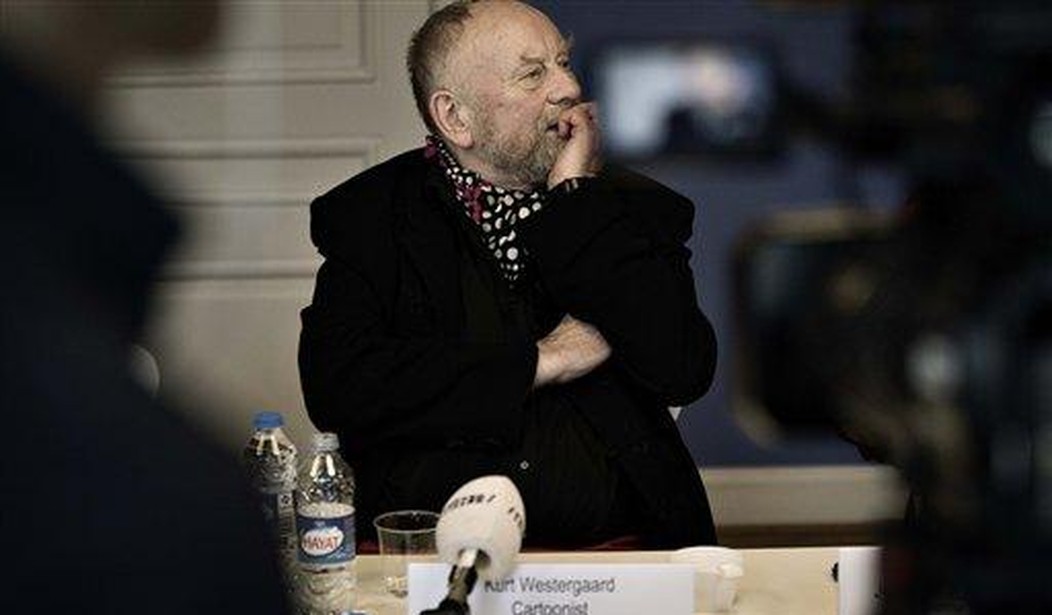One of the most consequential and least-known people of this young century died last Wednesday: Danish cartoonist Kurt Westergaard. You may not be familiar with Westergaard’s name, but you almost certainly know his most celebrated work: the cartoon of Muhammad, the prophet of Islam, with a bomb in his turban. That was the cartoon that set off worldwide rioting and a campaign that has now lasted for a decade and a half to compel the West to criminalize criticism of Islam under the guise of “hate speech.” The Left’s present all-out war against the freedom of speech began in great part in the furor over Westergaard’s cartoon.
Westergaard’s cartoon was the most arresting and provocative of the twelve cartoons of Muhammad that were published in the largest newspaper in Denmark, Jyllands-Posten, on September 30, 2005. As the book Islamophobia and Free Speech explains, the paper wasn’t trying to be gratuitously insulting. In the wake of the jihad murder of Theo Van Gogh, Danish author Kåre Bluitgen had found it difficult to find an illustrator for his book about Muhammad: Danish artists were all too afraid of jihadist violence. Frants Iver Gundelach, president of the Danish Writers Union, decried this submission to violent intimidation as a threat to free speech, and Jyllands-Posten took up the challenge.
Related: A Danish Cartoonist on the Run
Flemming Rose, Jyllands-Posten’s culture editor, approached 40 artists asking for depictions of Muhammad. In response, he received the 12 drawings he published, nine of which were eminently forgettable—and immediately forgotten. The other three pointed out the link between Islam and violence. One of the three, only Westergaard’s drawing was truly memorable.
By early November 2005, thousands of Muslims in Denmark were marching in demonstrations against the cartoons. Westergaard went into hiding. The Pakistani Jamaaat-e-Islami party offered 50,000 Danish kroner (around $7,500) to anyone who killed one of the cartoonists. The Organization of Islamic Cooperation (OIC) lodged a protest with the Danish government and began a campaign that continues to force the West to abandon the freedom of speech and criminalize “incitement to religious hatred.” Around the world, riots over the cartoons killed at least 139 people and injured 823.
On January 1, 2010, a Muslim migrant in Denmark took an axe to the door of Westergaard’s house, intent on killing him for insulting Muhammad; he got inside, but Westergaard and his five-year-old granddaughter were hiding inside a secure safe room, and the would-be murderer was shot by police. After that, Westergaard, who was 74 at the time of the attack, kept a low profile. Voices speaking out in his defense were few, and were defamed as “far-right.”
The isolation of Westergaard after the publication of his Muhammad cartoon typifies the paradox of the West’s response to jihad violence and Sharia oppression. In January 2006, Bill Clinton denounced “these totally outrageous cartoons against Islam,” adding: “So now what are we going to do?…. Replace the anti-Semitic prejudice with anti-Islamic prejudice?” The prejudice Clinton had in mind was apparently the idea that there might be some connection between Islam and violence. As his winsome and wise bride Hillary put it, “Muslims are peaceful and tolerant people and have nothing whatsoever to do with terrorism.”
So for Bill Clinton and his ilk, including the numerous establishment political and media figures who huffed self-righteously against Westergaard’s cartoon and the others, the cartoons were “outrageous” because at least some of them suggested a link between Islam and jihad terrorist violence. However, the Muslim migrant who hacked his way into Westergaard’s house on New Year’s Day 2010 wasn’t intent on killing the cartoonist because he had dared to suggest that Muhammad and Islam were violent. He was intent on killing Westergaard because he knew that Muhammad and Islam were violent, and that someone who had mocked Muhammad, as he believed Westergaard had done, deserved death. And he was in Denmark in the first place because the people who are certain that Islam is a religion of peace were intent on bringing him, and millions like him, there, with no concern for national security or cultural clashes at all.
Westergaard thus spent the last years of his life on the horns of a paradox: He was hated by the Leftist intelligentsia for suggesting that Islam was not a religion of peace, and by innumerable Muslims in Denmark and around the world because they knew that Islam was not a religion of peace.
The Left is now engaged in an increasingly open effort to destroy the freedom of speech and criminalize opposition to its agenda. A dry run for this effort was the stigmatization and marginalization of accused “Islamophobes,” and the consigning of criticism of Islam (not criticism of Judaism or Christianity) to the outer darkness of “hate speech.” Kurt Westergaard, with his cartoon poking mild fun at the fact that millions have been killed through the centuries in the name of the prophet of Islam and in accord with his teachings, committed an early example of that alleged “hate speech.” His abandonment by the self-appointed key thinkers and moral arbiters of the once-free world was a disquieting sign of what was to come.










Join the conversation as a VIP Member